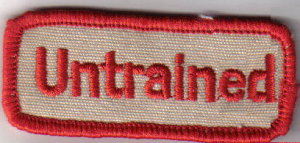 If you’re a regular reader of Ask Andy, the Net Commissioner, you might have seen this week’s column and you may have been nodding your head as you read along.
If you’re a regular reader of Ask Andy, the Net Commissioner, you might have seen this week’s column and you may have been nodding your head as you read along.
(If you haven’t seen it, please go read it now.)
TLDR: There was only one question – a lengthy one – from an enlightened assistant Scoutmaster whose son stumbled into a troop that was run by adults – something they called the “Troop Method”. He, and a few others, knew it was wrong, tried to change things to the Scouts’ benefit, but the old guard put their foot down. The ASM was wondering how to proceed.
You are more likely than not to have encountered some form of the method by which this troop operated. I found myself remembering that the troop my son selected was being run much this way when we first joined. The top leaders were untrained, unclear on the concept of Boy Scouts and the patrol method, and certainly none had taken any advanced training.
It took time and determination on my part to turn things around. Time, because when we joined, I hadn’t yet taken any training, and all I knew about how a troop operated was what I saw. Shortly after we joined the troop, I took Troop Committee Challenge (in person was the only way back then). I had trouble correlating what the troop was doing with what I had learned in training. At the same time, I saw the troop’s youth membership dwindle from around forty when we first visited to twenty within a couple years.
Eventually, after taking Wood Badge and Scoutmaster Position-Specific training – which wasn’t required for my position on the committee, but I felt it was important anyway – I started seeing how the patrol method worked, and took a few steps at a time to move the leadership (both youth and adult) in that direction. Sure, there was pushback from many of the adults, but when they saw the results – engaged, happy Scouts embracing responsibility and learning to do things for themselves – they came around.
Encouraged, I took all the online training available, read Scouting Magazine from cover to cover when it arrived, and read books and found online blogs and podcasts by respected Scouters who knew, understood and practiced Scouting by the patrol method, as Baden-Powell and Green Bar Bill intended.
Almost all of the troop adults have embraced and support the patrol method. The most satisfying moments are going back for visits to the troop and observing the differences between the way the troop was in those early days for us, and the way it is now.
I feel like my work has paid off in that there is a legacy of a renewed patrol culture in the troop that I helped in part to inspire. And had I not taken all the training I could take, the change might not have happened. Who knows, the twenty Scouts might have dropped a few more each year until there were no more, but instead the troop grew to where it now hovers around fifty youth members. And I’ve tried to pay it forward by staffing countless Troop Committee Challenge, Scoutmaster PST and Outdoor Leader Skills courses.
The bottom line in the Ask Andy tale is that you aren’t likely to change the entrenched adults. The only way to move forward is to remove and replace them, which has to be done by the chartered organization. Lacking change at that level, those dissatisfied with the way a troop operates should vote with their feet and find another troop that gets it. But to keep your troop from reaching that point, it’s important to not be one of “those guys.” Learn as much as you can – take all the training you can – and never stop learning.
This post first appeared on Bobwhite Blather.


